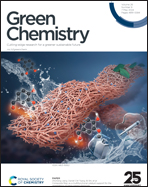Pathway and enzyme engineering for the bioconversion of lignin derivatives into homoeriodictyol in Saccharomyces cerevisiae†
Abstract
A sustainable lignin bioconversion depends on the exploitation of the inherent aromaticity of lignin for high-value aromatic products. However, the microbial valorization of lignin is hindered by the lack of established bioconversion routes or the inefficient heterologous expression of key enzymes. Here, an efficient biological lignin conversion route was constructed in a microbial cell factory by tapping the inherent aromaticity of lignin to produce aromatic natural compounds such as homoeriodictyol. The heterologous biosynthesis pathways were successfully constructed to convert lignin-derived monomers to homoeriodictyol in Saccharomyces cerevisiae. The implementation of combinatorial regulating strategies resulted in enhanced CoA supply, suppression of branch pathways, and upregulation of the rate-liming enzymes, which increased the titer of homoeriodictyol by a remarkable 22.5-fold. After that, engineering cofactor supply and recycling led to a substantial 95% increase in homoeriodictyol production. The rational design and modification of the heterologous rate-limiting enzymes helped achieve substantial improvement in the homoeriodictyol yield. All these strategies together enabled the record homoeriodictyol titer of 3.2 mmol l−1 from lignin derivatives by S. cerevisiae. Overall, such an innovative conversion route meets the atom-economy concept by converting lignin derivatives into valuable flavonoids, paving a green, sustainable way for both the valorization of lignin and the production of aromatic natural products.



 Please wait while we load your content...
Please wait while we load your content...